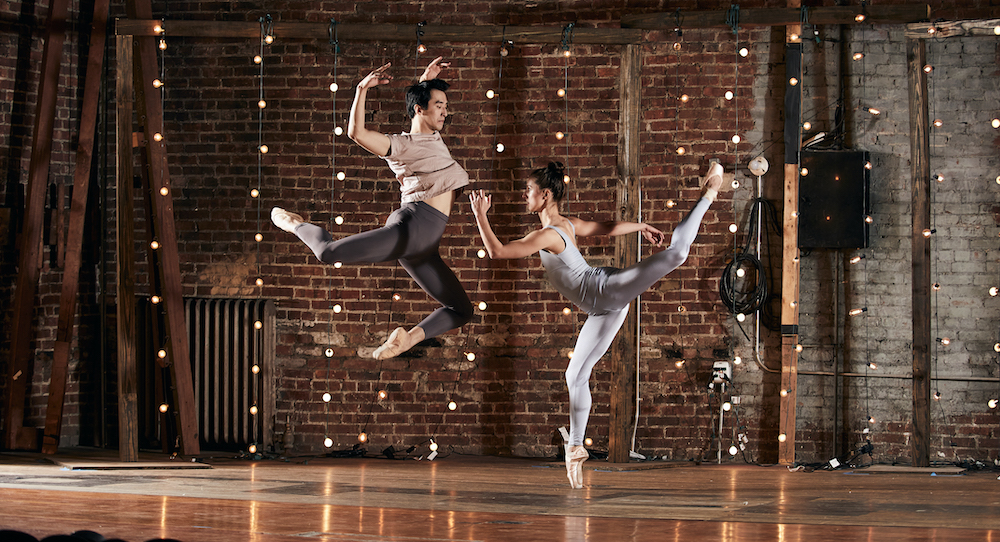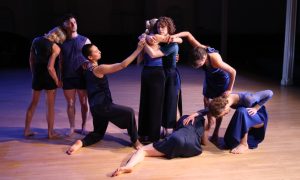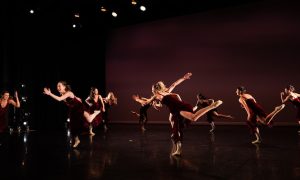The Jane Pickens Theater, Newport, RI.
July 31, 2022.
The summer night I enjoyed Revolve Dance Project’s 2022 Season program was one of those perfect days out there, with the kind of natural beauty and perfect weather that’s hard to do justice with words. A beautiful breeze, not-too-strong sun, everything around lush and green: it can all come together to make, in present moment experience, all of these natural qualities multiply each other.
As I took in the program, I thought about how movement and live music can come together to similar effect – to immerse us, all of us, in an unparalleled experience. That is, arguably, what Providence, Rhode Island-based Revolve Dance Project seeks to create; the company is “dedicated to creating world premiere dance and music collaborations and performing them live for our community” (www.revolvedanceproject.com). These artists seem keen on exploring what can happen when such collaborations blossom – and blossom they did in this program, the company’s second annual.
The program opener – Ty Paramenter’s do you they make a sound? – took me right into its classy jazz club world, firmly and confidently by the hand. Live musicians did their work (playing a score from Cameron MacIntosh) upstage of the dancers (Kailee Felix and Tegan Rich). Behind them were stringed lights hanging down the backdrop like vines, bathing the stage in soft light. The dancers came out and began the piece with a firework explosion of movement: full of athleticism, but also ease and groove.
That aligned with the clear, yet diffusing notes of the live music. Kinetic and rhythmic force came together to be more than the sum of their parts. Also clear was the pared-down elegance of the overall aesthetic – with that soft light from the stringed lights on the backdrop and dancers wearing stylized pedestrian.
At the same time, the movement had enough power and technical daring to impress, but not at the expense of truly seeing the souls onstage. The work felt more like an exploration of how this movement and score could come together than like a specific narrative – so I could indeed experience these individuals simply being in the power of their bodies and the art at hand.
Coming second was Katherine Bickford’s solo Idle Frustrations, danced by Eugenia Zinovieva. This work also brought score (from cellist Daniel Hass) and movement together in a way that burgeoned further aesthetic magic. The vibrant notes in the classical score jumped all over the scale, and movement similarly explored a vastness of possibilities.
Zinovieva danced all of it with a commanding presence; she knows how to use her technical strength, long limbs, and supple spine to bring out the minute wonders in the movement and musicality at hand. Yet she also knows how to hold just enough back to keep us wanting more, as well as for her artistry to feel honest. Athleticism can draw our eyes and wow our spirits, but the deeper levels of feeling and humanness is what can really move us.
Bickford’s thoughtful choreography offered such authenticity and feeling in spades: integrated and attuned, yet not too smoothed out and pleasantly polished. It also seemed like she truly knew how to bring out the best in her soloist.
Third in the program was an emotional duet to a live cover of Deathcab for Cutie’s “Transatlantacism”, a ballad on the challenges of separation from someone you love by distance. Ariel Rose’s duet of the same name painted in movement the picture of such challenges, in a way that was definitive yet also not too spelled out for us in the audience. The dancers, Kirsten Evans and Alex Lantz, moved apart for most of the piece – sometimes simultaneously, sometimes one holding a shape while the other moved.
They didn’t make contact except for in one short, sweet moment (all too short in the context of the story at hand, that is). As the song expressed “I need you so much closer,” the two individuals on stage seemed to be so close, yet so far away from further contact: moving parallel across the stage, moving in the path that their partner had just crossed, dancing in unison yet not in the same physical space.
Were some of those alignments missed opportunities for more connection? That’s a question that could tease the mind of audience members while the energetically and technically beautiful movement filled the stage. It was balletic, yet with lovely release and freshness of shaping through port de bras, as well as firm weightedness into the stage.
All in all, it felt like a love story in ballet fitting the sensibilities and aesthetics of 2022. The ending only made it all the more poignant and memorable: Lantz slowly carried Evans upstage as the lights dimmed to darkness. Though it was nothing like easy, they found some sort of sustained connection in the end – and, one could argue, that’s what really counts.
Coming fourth was Ruka White’s Press On Nails, a thoroughly delightful ensemble piece of women reveling in their own sensuality and femininity. That focus didn’t need to take away from their strength, of course, and it didn’t here. With skill and vibrancy, they offered movement peppered with a variety of influences: hip hop, jazz, Latin dance and social dance (perhaps in an improvisational moment, there was even a bit of twerking!).
The five dancers moved through lines, circles and clumps – as if shifting their place and who they’re with at a house party (as we sometimes do). At other points, individual dancers also had moments to shine, with their ensemblemates looking on and whispering to one another – creating little moments of drama that were also truthful to the party atmosphere at hand.
With an ensemble moving so dynamically and joyfully, the work felt like something on Broadway: with all of these classic qualities, yet with aesthetic and stylistic touches more aligned with the modern day. They ended in a tableau, one full of sass and confidence – and therein harmonious with all of those choices and the little world at hand here.
Celebration filled the stage throughout the work, and then the air all throughout the theater – celebration of the strength and possibility in their bodies, and of the vivacious music that helped move them (from Dizzy Gillespie), it felt like. Sometimes we just need to revel in those things, even in (arguably especially in) hard times.
The energy shifted into something softer, slower, more reflective with Dara Capley’s what will you take with you? Jacob Hoover, Joe Lynch and Brenna Zgodic danced the trio. Their classical, yet softened shapes moved with the tonal ebbs and flows of the live accompaniment (from guitarist and composer Laden Valley). The ensemble molded in and out of those shapes, breath fueling their pleasing continuity and kinetic attunement.
They shaped themselves around one another’s shapes as well, that physical attunement reaching beyond themselves. Contrasts and tensions between their separate movement offerings even counterbalanced one another. A relationship in space between the dancers all grew through these qualities – yet, like blobs oozing upward in a lava lamp, they were also fully distinct as autonomous agents.
The ease in their movement – not needing to push to the fastest, biggest, most athletic possibility – also stuck with me. It was pleasing energetically, but also felt poignant in this world of faster, stronger, longer, harder. Dance can show us that so much more is available to us.
Last in the program came Kurt Douglas’ Unearthed/In Everything, with a bluesy rock vibe but also smooth contemporary cool. The way that bluesy rock (from Josh Knowles) came together with powerful movement made this work a great closer for a program that illustrated what can be possible when music and movement come together in thoughtful, cohesive ways.
Douglas’ movement called on clever formations and shifts in formations – bisecting a circle to break it up, for example. The movement vocabulary was just as fresh and earnest, with fluid spinal release and transitions guided by true physical integration. It all felt like a steady stream of movement, flowing by the rhythm of the score.
Two memorable duets came at the middle of the work, maintaining all of those qualtiies and also bringing a touching sense of mutual support between pairs of humans. It was all intricate, yet also straightforward – illustrating the honest, pure beauty of bodies moving together.
That sense of support grew to a wider scale in a following section, with one dancer moving alone but the group behind her – with a sense in the ether that they had her back. It all climaxed, with the score picking up speed and volume and the dancers picking up speed and size in their movement to match. The energy at hand then softened, and the dancers moved offstage as the lights dimmed.
That energy buzzing throughout the space wouldn’t just dissipate in a moment – it lay heavy in the air. The aesthetic and kinetic beauty, the connection and support amongst souls: it would all continue, and illustrate a new path forward for us in the audience before we headed back into our frenetic lives.
It was all possible because music and movement can come together and multiply their individual effect – if brought together with intention and purpose, like the artists of Revolve Dance Project did for this program. Immersed in such offerings, we can remember just how much magic is really out there in this world – within our reach if we keep our senses, all of our senses, open to it.
By Kathryn Boland of Dance Informa.















